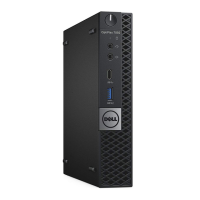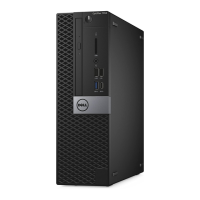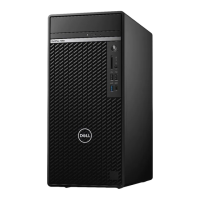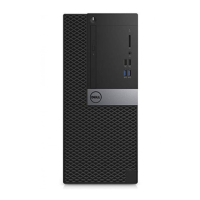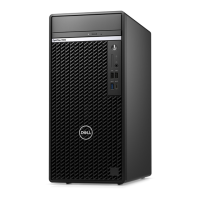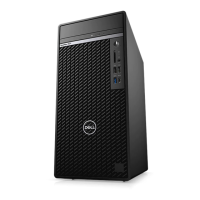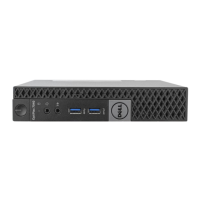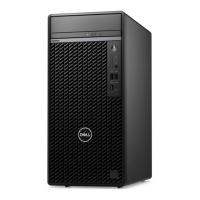Do you have a question about the Dell OptiPlex 7050 Tower and is the answer not in the manual?
Safety guidelines to protect your computer and ensure personal safety.
Steps to follow before performing internal computer maintenance or repair.
Procedures for shutting down the computer in Windows 10 and Windows 7.
Steps to reconnect devices and ensure proper operation after internal work.
Lists essential tools required for component removal and installation procedures.
Instructions for removing and installing the computer's back cover.
Steps to properly reinstall the computer cover.
Instructions for removing and installing the computer's front bezel.
Procedures for removing and installing storage devices like hard drives.
Instructions for removing and installing the optical drive.
Instructions for removing and installing M.2 PCIe SSDs.
Instructions for removing and installing the SD card reader.
Instructions for removing and installing memory modules (RAM).
Instructions for removing and installing expansion cards.
Instructions for removing and installing the power supply unit.
Instructions for removing and installing the VGA daughter board.
Instructions for removing and installing the chassis intrusion switch.
Instructions for removing and installing the computer's power switch.
Instructions for removing and installing the internal computer speaker.
Instructions for removing and installing the coin cell battery.
Instructions for removing and installing the heat sink assembly.
Instructions for removing and installing the CPU processor.
Instructions for removing and installing the system cooling fan.
Instructions for removing and installing the computer's system board.
Provides a general description of the M.2 Intel Optane memory module.
Details the driver requirements for the Intel Optane memory module.
Instructions for removing the M.2 Intel Optane memory module.
Lists detailed technical specifications for the M.2 Intel Optane memory module.
Information on environmental operating conditions for the module.
Common issues and solutions related to the M.2 Intel Optane memory module.
Overview of Universal Serial Bus (USB) technology and its evolution.
Details features and benefits of USB 3.0/3.1 Gen 1.
Discusses common applications and products using USB 3.0/3.1 Gen 1.
Explains compatibility of USB 3.0/3.1 Gen 1 with previous versions and OS.
Lists and describes the features of the HDMI 1.4 standard.
Highlights the benefits of using HDMI for audio and video transfer.
How to configure the computer's boot device order.
Explains the keys used for navigating System Setup.
How to set and manage system and setup passwords for security.
Procedure to modify or remove existing system and setup passwords.
Details system configuration options like NIC, SATA, USB, and Audio.
Options for configuring the primary display settings.
Security options including admin password, TPM, and Secure Boot.
Settings for enabling and managing Secure Boot and its keys.
Options for Intel SGX for secure computing environments.
Settings for processor performance like core support and speed.
Options for managing system power states and wake-up behavior.
Settings related to the Power-On Self Test (POST) behavior.
Manageability features like USB provision and MEBx hotkey.
Options for enabling Intel Virtualization Technology.
Maintenance options like Service Tag, BIOS Downgrade, and Data Wipe.
Procedures for updating the BIOS.
How to configure the system to wake up from sleep states.
Lists the operating systems supported by the computer.
General instructions for downloading drivers from Dell's support site.
Steps to download and install the chipset driver.
Information on verifying and identifying Intel chipset drivers.
Steps to download and install graphics drivers.
Information on verifying Intel HD Graphics drivers.
Instructions for updating Wi-Fi and Bluetooth drivers.
Information on verifying Realtek HD audio drivers.
Steps to download and install audio drivers.
Explains diagnostic codes indicated by the power LED status.
Discusses specific power LED behavior and its causes.
Introduction to Dell's ePSA diagnostic tool.
Step-by-step guide to running the ePSA diagnostic tests.
Lists and explains various diagnostic error messages and their causes.
Lists and explains system error messages and their troubleshooting steps.
How to check system memory status in Windows 10 and 7.
How to check system memory status via the BIOS/System Setup.
Using the ePSA tool to test system memory.
Details the specifications of the processors used in the OptiPlex 7050.
Lists the specifications for the computer's memory modules.
Details the video controller and video memory specifications.
Lists the specifications for the audio controller and amplifier.
Details network adapter and wireless communication specifications.
Lists the types and capacities of storage devices supported.
Details the types and number of ports and connectors on the system.
Lists the specifications for the system's power supply unit.
Diagram and labels for components on the system board.
Describes the function of power buttons and activity lights.
Details operating temperature, humidity, and shock/vibration limits.
Information on how to contact Dell support for assistance.
Safety guidelines to protect your computer and ensure personal safety.
Steps to follow before performing internal computer maintenance or repair.
Procedures for shutting down the computer in Windows 10 and Windows 7.
Steps to reconnect devices and ensure proper operation after internal work.
Lists essential tools required for component removal and installation procedures.
Instructions for removing and installing the computer's back cover.
Steps to properly reinstall the computer cover.
Instructions for removing and installing the computer's front bezel.
Procedures for removing and installing storage devices like hard drives.
Instructions for removing and installing the optical drive.
Instructions for removing and installing M.2 PCIe SSDs.
Instructions for removing and installing the SD card reader.
Instructions for removing and installing memory modules (RAM).
Instructions for removing and installing expansion cards.
Instructions for removing and installing the power supply unit.
Instructions for removing and installing the VGA daughter board.
Instructions for removing and installing the chassis intrusion switch.
Instructions for removing and installing the computer's power switch.
Instructions for removing and installing the internal computer speaker.
Instructions for removing and installing the coin cell battery.
Instructions for removing and installing the heat sink assembly.
Instructions for removing and installing the CPU processor.
Instructions for removing and installing the system cooling fan.
Instructions for removing and installing the computer's system board.
Provides a general description of the M.2 Intel Optane memory module.
Details the driver requirements for the Intel Optane memory module.
Instructions for removing the M.2 Intel Optane memory module.
Lists detailed technical specifications for the M.2 Intel Optane memory module.
Information on environmental operating conditions for the module.
Common issues and solutions related to the M.2 Intel Optane memory module.
Overview of Universal Serial Bus (USB) technology and its evolution.
Details features and benefits of USB 3.0/3.1 Gen 1.
Discusses common applications and products using USB 3.0/3.1 Gen 1.
Explains compatibility of USB 3.0/3.1 Gen 1 with previous versions and OS.
Lists and describes the features of the HDMI 1.4 standard.
Highlights the benefits of using HDMI for audio and video transfer.
How to configure the computer's boot device order.
Explains the keys used for navigating System Setup.
How to set and manage system and setup passwords for security.
Procedure to modify or remove existing system and setup passwords.
Details system configuration options like NIC, SATA, USB, and Audio.
Options for configuring the primary display settings.
Security options including admin password, TPM, and Secure Boot.
Settings for enabling and managing Secure Boot and its keys.
Options for Intel SGX for secure computing environments.
Settings for processor performance like core support and speed.
Options for managing system power states and wake-up behavior.
Settings related to the Power-On Self Test (POST) behavior.
Manageability features like USB provision and MEBx hotkey.
Options for enabling Intel Virtualization Technology.
Maintenance options like Service Tag, BIOS Downgrade, and Data Wipe.
Procedures for updating the BIOS.
How to configure the system to wake up from sleep states.
Lists the operating systems supported by the computer.
General instructions for downloading drivers from Dell's support site.
Steps to download and install the chipset driver.
Information on verifying and identifying Intel chipset drivers.
Steps to download and install graphics drivers.
Information on verifying Intel HD Graphics drivers.
Instructions for updating Wi-Fi and Bluetooth drivers.
Information on verifying Realtek HD audio drivers.
Steps to download and install audio drivers.
Explains diagnostic codes indicated by the power LED status.
Discusses specific power LED behavior and its causes.
Introduction to Dell's ePSA diagnostic tool.
Step-by-step guide to running the ePSA diagnostic tests.
Lists and explains various diagnostic error messages and their causes.
Lists and explains system error messages and their troubleshooting steps.
How to check system memory status in Windows 10 and 7.
How to check system memory status via the BIOS/System Setup.
Using the ePSA tool to test system memory.
Details the specifications of the processors used in the OptiPlex 7050.
Lists the specifications for the computer's memory modules.
Details the video controller and video memory specifications.
Lists the specifications for the audio controller and amplifier.
Details network adapter and wireless communication specifications.
Lists the types and capacities of storage devices supported.
Details the types and number of ports and connectors on the system.
Lists the specifications for the system's power supply unit.
Diagram and labels for components on the system board.
Describes the function of power buttons and activity lights.
Details operating temperature, humidity, and shock/vibration limits.
Information on how to contact Dell support for assistance.
| Form Factor | Tower |
|---|---|
| Processor Options | 7th Generation Intel Core i7/i5/i3, Intel Pentium, Intel Celeron |
| Chipset | Intel Q270 |
| Memory | Up to 64GB 2400MHz DDR4 |
| Storage Options | 2.5-inch HDD/SSD, M.2 SSD, 3.5-inch HDD |
| Graphics Options | AMD Radeon R7 450 |
| Operating System Options | Windows 10 Pro, Windows 10 Home, Ubuntu Linux |
| Ports | USB 3.1 Gen 1, USB 2.0, HDMI, DisplayPort, Audio |
| Ports (Front) | 2 x USB 3.1 Gen 1, 2 x USB 2.0 |
| Ports (Rear) | 4 x USB 3.1 Gen 1, 2 x USB 2.0, HDMI, DisplayPort, Serial, Audio, RJ-45 |
| Expansion Slots | 1 x PCIe x16, 1 x PCI |
| Optical Drive | DVD-ROM, DVD+/-RW |
| Network | Integrated Intel I219-LM Ethernet LAN 10/100/1000 |

